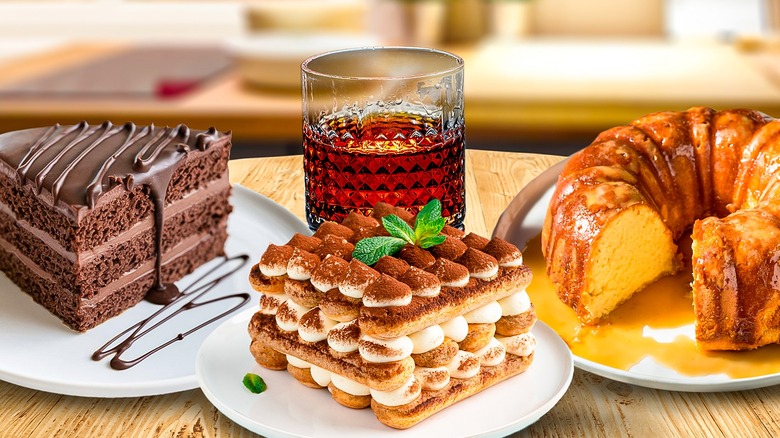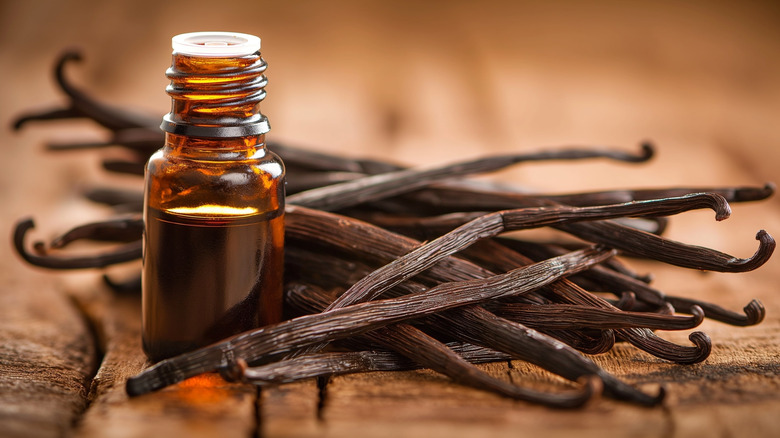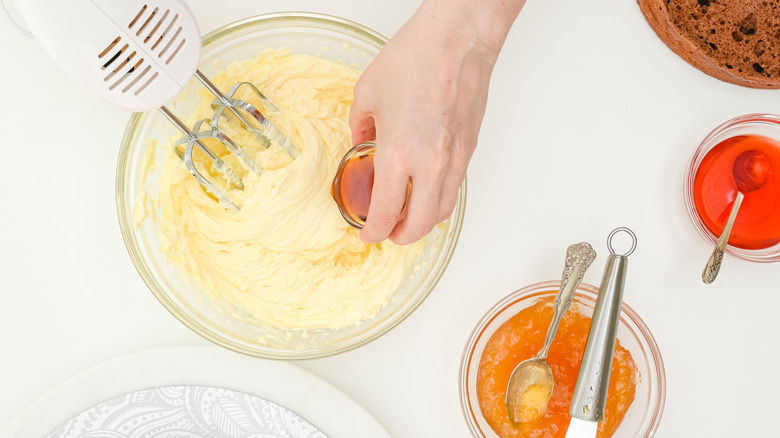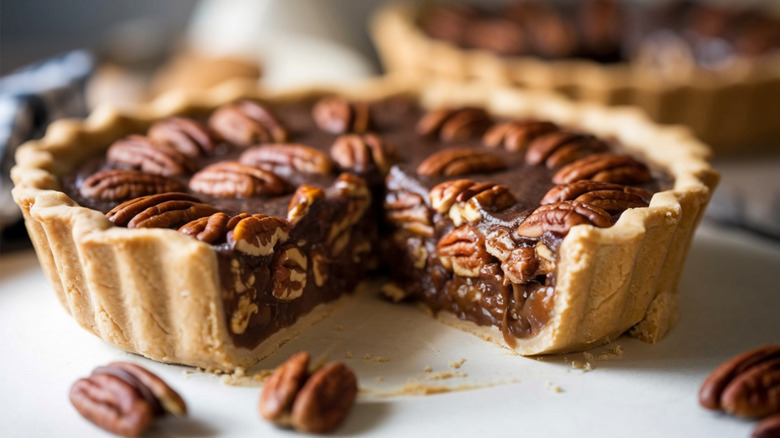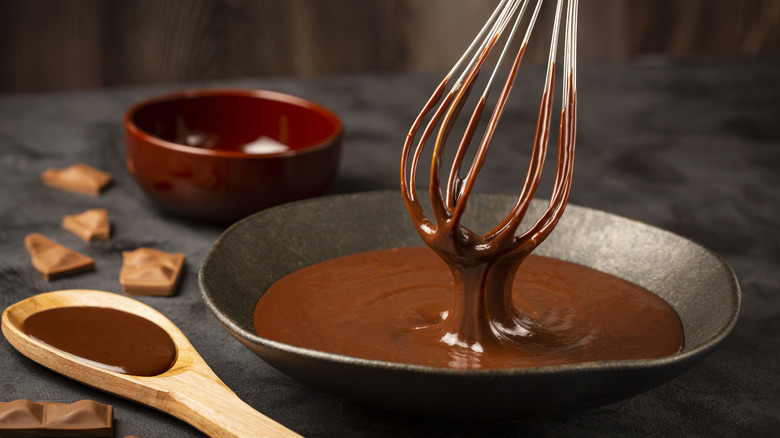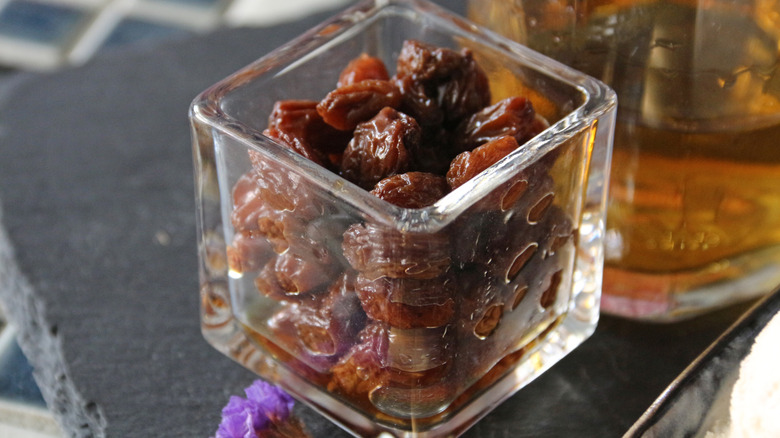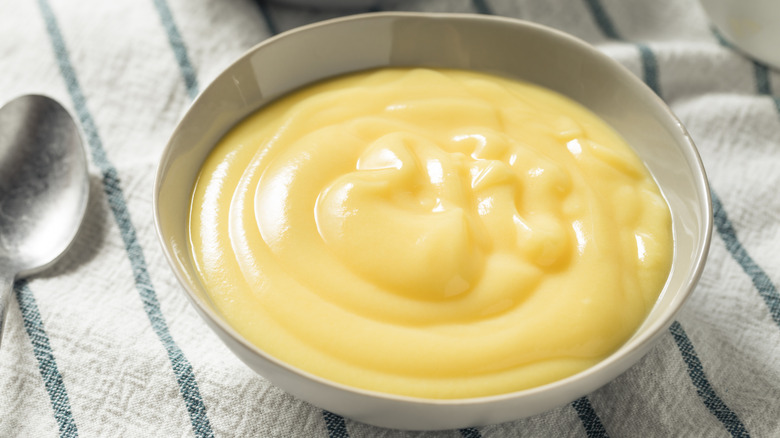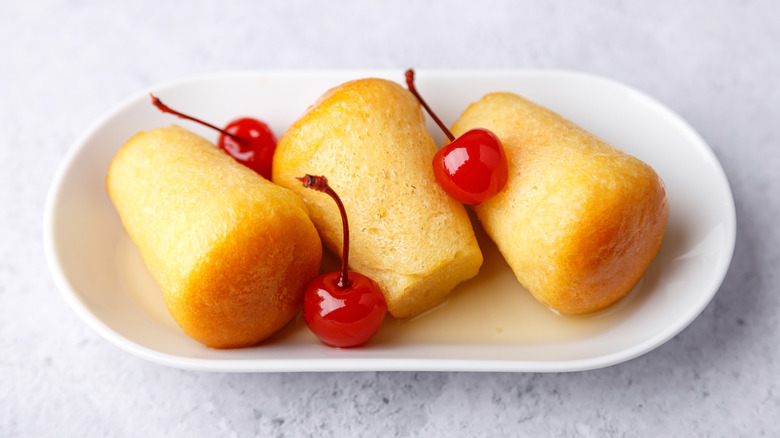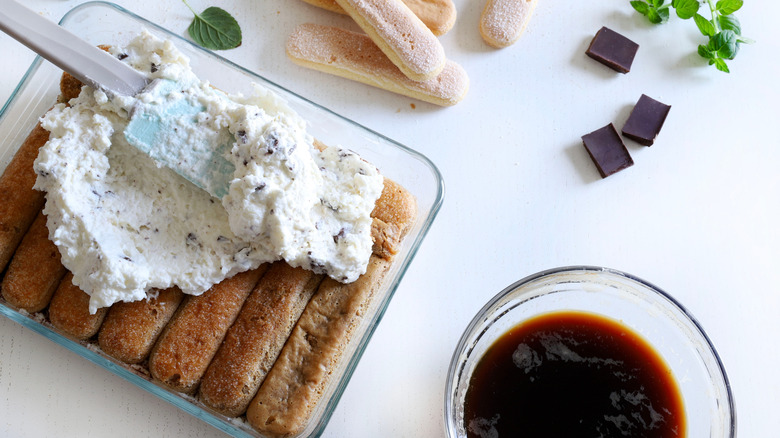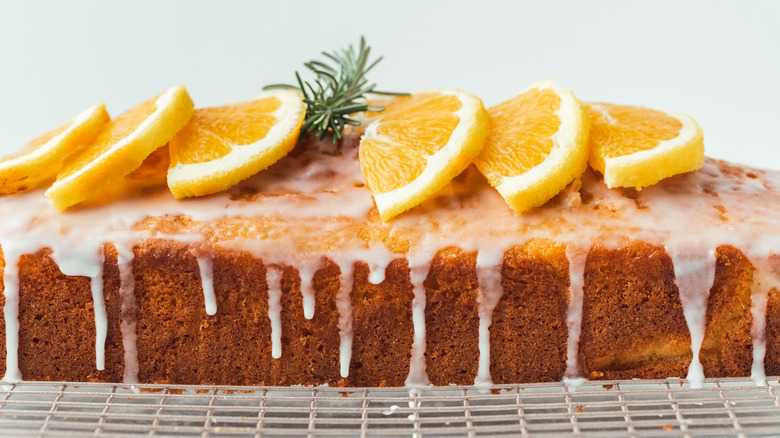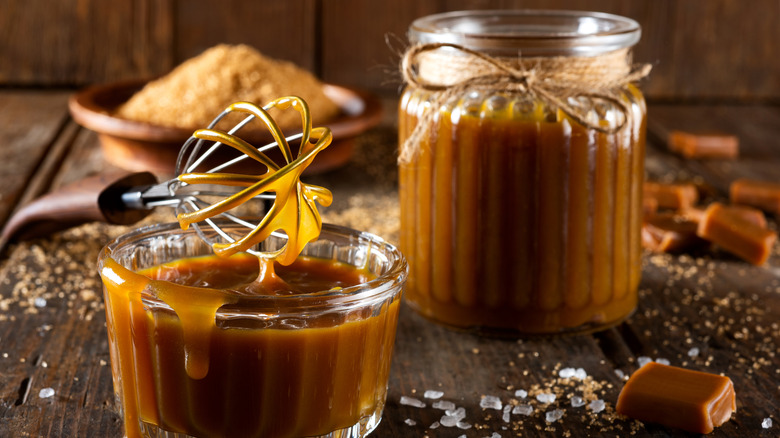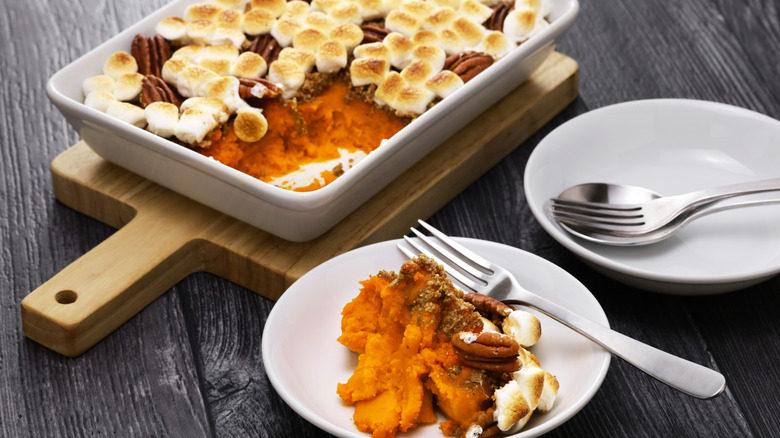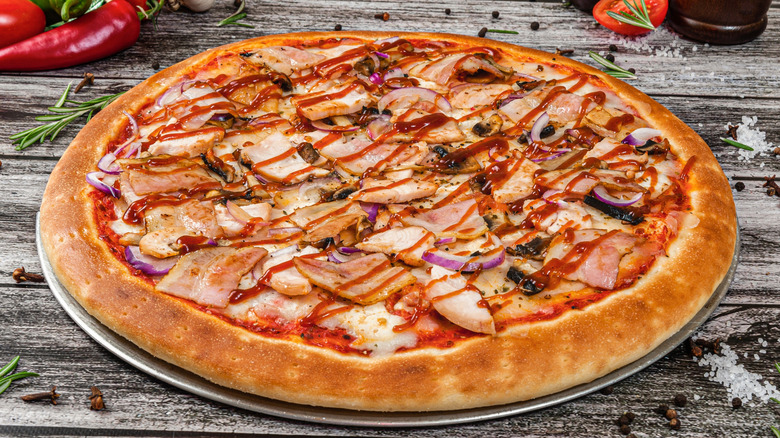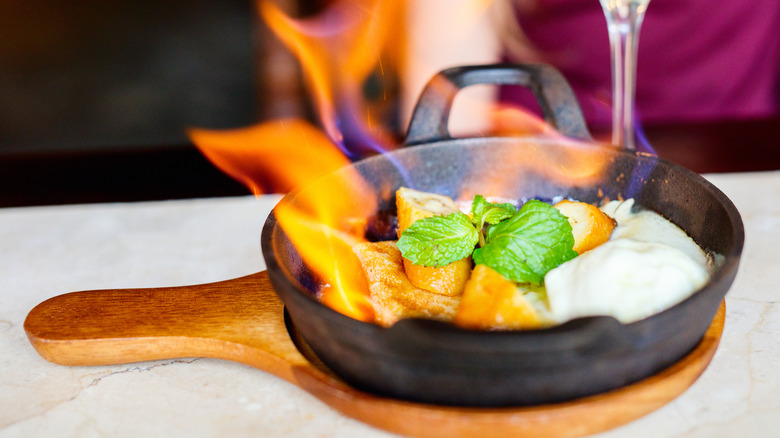13 Ways To Infuse Liquor Into Baked Goods
Even if you craft a couple of cocktails each week at home, you're probably sitting on liquor bottles for longer than you'd like. While hard liquors literally last a lifetime, why wait to enjoy them, knowing they still gradually lose quality once opened? Before they start collecting dust, use them for more than just your next daiquiri. A creative option for making the most of your liquors is to infuse them in baked goods, and I have 13 bold ideas for you here.
As a serious imbiber of wine and spirits, I own a constantly rotating supply of liquor. Not only do I know how to make a mean martini, but I also understand how to use alcohol in the kitchen. And with my lengthy pastry background, I have years of recipe development experience and established techniques on how to incorporate liquor in a wide range of desserts and baked goods. Working in restaurants, it's easy to access the full selection of liquor at the bar — with the caveat of trading bottles for tester batches with the bartenders to maintain that useful work connection!
My parameters for the type of alcohol will be limited solely to liquor — distilled hard spirits such as whiskey, bourbon, vodka, rum, gin, and tequila. When incorporating liquor into baked goods, I have a useful mantra and one that I strongly suggest you follow, too: Start small. Begin with a tablespoon or two. It's always easy to add more, but it's impossible to take back the accidental heftier pours.
1. Create your own DIY vanilla extract
Add an item to your pantry any home baker will love: made-from-scratch vanilla extract. I started doing this as a solution to avoid crying over waste from the pricey Madagascar vanilla beans one of my kitchen jobs buys for making caramels. Since the pods get stuck in the machine attachments, we scrape out the seeds to use, leaving behind the pods.
Making vanilla extract is a simple process, with liquor and vanilla beans as the only two ingredients you need. For the most versatile option similar to a store-bought bottle of extract, use high-quality vodka. For a more distinct extract with a personalized touch, choose your preferred whiskey or rum.
Here's the basic method to yield one 8-ounce bottle: Split 2 vanilla bean pods in half to expose the interior, and place the pods in a clean and sterilized 8-ounce bottle with an airtight lid, like a screw top or a swing top. Carefully pour 1 cup of liquor into the bottle with a funnel. Tightly secure the lid, and store in a cool and dry location with no direct sun exposure for at least six months or up to one year. The amount of time depends on how strongly you wish to infuse the vanilla. If you're using empty pods like I do, infuse for the full year to extract as much as possible with what remains.
2. Add a splash in batters and doughs
Enjoy the ease and versatility of mixing assorted liquors into batters and doughs. Add a small amount in your recipes for cakes, cheesecakes, brownies, and cookie doughs, without the risk of altering the texture or compromising the final baking outcome. In fact, you shouldn't alter the other liquid ingredients at all, since hard unflavored spirits have a lower water content and virtually no proteins or fats compared to baking liquids like milk or heavy cream. Therefore, treat the measurement of liquor as you would an extract, using it as a flavoring agent and adding it when you mix in the other liquid ingredients.
For some ideas, make a boozy eggnog cheesecake with spiced rum and freshly grated nutmeg mixed into the cream cheese base, or fudgey chocolate brownies using a portion of rye flour and a splash of rye whiskey. And I would be remiss not to tell you how one of my former pastry chefs would add a little rum to her classic banana bread recipe, which serves to elevate the fruity flavors and aromas to an extremely delicious level. Once I learned that trick, I have never made banana bread any other way.
3. Booze up your pies
Don't tell your grandma ... we're downing some shots while eating our family's famous pecan pie this year. Pouring a splash or two of booze into pie fillings is a fun way to breathe new life into classic bakes and introduce attention-grabbing flavors.
The popular category of fall-weather favorites is a perfect place to start. Pecan, pumpkin, sweet potato, and apple pies naturally go well with warming liquors like whiskeys, bourbons, and spiced dark rums. Alton Brown swears by rye whiskey in his pecan pie, as it balances the excessively sweet nature of the filling. Cranberry pie with gin is another blissfully boozy match.
Outside of a sloshed filling, there are also major benefits to adding liquor to pie dough as a gluten inhibitor. With its low water content, liquor prevents significant gluten development as you mix the flour together with the other liquid ingredients, making the dough more pliable and easier to handle when rolling and shaping. Plain vodka is the typical choice for this quick trick, as its clean and flavorless finish won't be detected in the pie. Even though you could argue that the small amount needed in the recipe (roughly ¼ cup) lends itself to some versatility of liquor, I would recommend saving the juniper-forward gin or smoky whiskey for other uses.
4. Make a ganache with a bang
You know Coco Chanel's famous saying to remove one accessory before leaving the house? Ganache is the accessory you absolutely want to leave on. In my experience, ganache has never failed at its ability to act as a complementary component in desserts, with its gorgeous, silky cloak of decadence. A simple fusion of chopped chocolate and heavy whipping cream, customizing the base is easy and fun with a wink of something special.
Applied in small quantities, liquor brings a whole new personality to ganache, particularly when you get creative with flavored liquors. I've made peanut butter whiskey milk chocolate ganache as a macaron filling, blood orange vodka dark chocolate ganache for an elegant winter tart, and honeyed gin to add to a white chocolate ganache drizzled over lemon cookies, inspired by a bee's knees cocktail. Tap into your own creative prowess to use a boozy ganache as a foundation to build multi-flavored and multi-layered pastries, cookies, cakes, and more.
5. Macerate fresh and dried fruits
Dried fruits have so much potential, but they're quiet about it at first, shriveled in their own shyness. So if they need a little liquid courage to coax out some of their better qualities, I'm their best wing woman to nudge them into the spotlight. Macerating dried fruits in liquid softens the dehydrated chewiness, revitalizing them into plump and juicy pieces that still have tons of textural character.
If you're determined to pursue bold flavors, let that liquid be none other than liquor. We tested this method at one of my previous jobs while working on a rum raisin ice cream recipe. We discovered that gently heating the dried raisins in rum for 20-ish minutes on low heat, as opposed to soaking them slowly overnight, was a considerably faster and more effective method to macerate. This heating technique can be applied to all dried fruits, keeping in mind to cut larger units like dried apricots into bite-sized pieces and cool them to room temperature before using. Try it when you want to make a boozy carrot cake, moist fruit cake, or a zingy Irish soda bread.
But don't let dried fruits hog the bottle. Fresh fruits can get in on the stash, too. Consider soaking fresh pitted cherries in liquor and sugar before using them in a Black Forest cake, or macerating fresh berries or stone fruit to serve on top of cakes, quick breads, or baked meringues.
6. Whisk into creamy custards
Updating basic custard recipes like pastry cream, crème caramel, crème brûlée, sabayon, ice cream, and crème anglaise is as simple as whisking in some liquor. Smooth, creamy custards offer one of the best bases for liquors — the fatty sweetened liquids serve as a perfect contrast to strong, smoky, and spicy alcohols like whiskey, tequila, and rum.
At a restaurant where I worked on the pastry team, a popular dessert was a thick square of chocolate bread pudding warmed in the oven to order. Our bread pudding recipe involved an overnight soak of stale brioche bread in a pool of thick chocolate custard sauce mixed with bourbon. It's no surprise it was a top-selling menu item.
While you can play around with the amounts of alcohol for most styles of custards, you do need a more careful hand when adding liquor to ice cream bases. Because distilled spirits have a lower freezing point than water, their addition to an ice cream base will alter the setting strength of the ice cream as it freezes, thwarting the formation of some of the ice crystals and leading to a softer texture. I stay within the limit of ¼ cup of spirit to 1 quart ice cream base. The ice cream will still set properly without the risk of remaining too liquidy after churning.
7. Saturate baked cakes
A baked cake is delicious on its own, pure and simple. But some cakes are destined to be unabashedly drenched in liquor. The soft crumb of the cake interior is able to gradually absorb liquid applied to the surface. And if that liquid includes liquor, even better. A common trick that many bakeries and pastry departments employ is to brush cake layers with milk or simple syrup to maintain the crumb's moisture, a surefire way to prevent the cakes from drying. And I have often whisked in a splash of booze for more oomph.
I share a close connection to baba au rhum, having made dozens upon dozens of this sweetened yeasted cake for pastry school. Baked in individual molds, they are a precious treat to make at home for any special occasion. Once the cakes are baked and allowed to cool outside of their molds, they are then soaked in a hot rum sugar syrup until plump and served while still warm.
For another idea — one that doesn't involve as many complicated steps as baba au rhum or a multi-tiered cake — a poke cake is easy and so effective. Once you bake your sheet cake and poke holes throughout the surface, you have free rein to saturate it with a spiked sauce, syrup, pastry cream, or sweetened condensed milk.
8. Soak crisp cookies
Acting like a dry sponge, a crisp cookie soaks up liquor faster than a speeding Bulleit Rye Whiskey. It's ideal for creating quick and impactful flavor infusions in just a tiny amount of time.
This technique is at its finest when applied to the Italian dessert tiramisu. At its most essential, this dish features layers of sweetened mascarpone cream and ladyfingers soaked in coffee. But a traditional adults-only customization, and my personal preference for making tiramisu both at work and at home, is to mix some alcohol like rum or bourbon with the coffee before soaking. This one is easy to taste-test, since you can take a quick slurp of the mix before soaking the cookies, and decide if you want to add any more for a stronger impression.
No-bake bourbon balls are another sweet treat that enjoys a glug or two of liquor in its mix. Recipes vary, but a popular version includes grinding vanilla wafers into fine crumbs in a food processor before mixing with nuts, sugar, and bourbon. The dry mix quickly soaks in the bourbon to form into a dough, which is then rolled and refrigerated.
9. Spike the final glaze or frosting
From glassy glazes to fluffy frostings, the finishing touches on your sweets can most definitely be spiked to achieve a sweet and subtle whisper of liquor. A powdered sugar glaze provides a big blank canvas that welcomes other ingredients, and it's often drizzled on top of cakes, cookies, and assorted pastries. With such a simple base, there's no need to be coy playing with quirky flavor combinations. I've used a margarita cocktail as repeat inspiration, focusing on its ingredients of tequila, orange liqueur, lime, and salt. With that combination, I have crafted orange zested shortbread cookies or pound cakes with a tequila and lime juice glaze sprinkled with flaky sea salt.
Basic frostings and buttercreams can be taken to the next level by using a splash of liquor in lieu of any extracts. Proceed as you normally would when whipping up the recipes, with the quick alteration of using your choice of liquor to replace the extract. I have transformed a plain buttercream recipe into a spicy delight by using a cinnamon spiced whiskey instead of vanilla extract, and used that to decorate vanilla cupcakes. You could also make a basic foolproof whipped cream packed with some powerful proof as an easy-to-make topping for different desserts.
10. Serve a sauced dessert sauce or spread
A sauced sauce is the way to go for a bold finishing touch to your bakes. And because it can be served on the side, it's a thoughtful choice when you have guests with a range of palates or ages who may not want (or shouldn't consume) a mighty spirit.
When it comes to a spiked caramel sauce for drizzling over desserts, I choose whiskey — usually bourbon. What makes bourbon distinct from other styles of whiskey, is its grain makeup and aging process. Bourbon must be produced with at least 51% corn in the grain mix, and it must be aged in new charred oak barrels. With that in mind, think of all the sweeter tasting notes in bourbon, like vanilla, toasted nuts, browned butter ... and caramel!
Outside of the sugary-sweet caramel realm, add some bold flavor to more basic spreads for generously slathering on fresh-from-the-oven bakes like scones, biscuits, breads, and muffins. A subtly spiked restaurant-worthy butter, with hints of honey and bourbon or agave and tequila, would be a huge hit at the brunch table.
11. Pair with veggies for a sweet-and-savory side
Certain hearty vegetables like sweet potatoes, yams, and assorted winter squashes can mingle on the sweeter side of the flavor territory. And guess what else can snuggle in just as nicely with them? Yup, liquor.
Bring out the family cookbooks, and turn the page to your favorite comforting homemade casserole dishes. The underlying caramelized and nutty notes of whiskey spirits pair perfectly with a recipe like baked sweet potato casserole, especially when you can mimic those flavors by including ingredients like toasted nuts or a layer of marshmallows that are lightly browned on top.
And when the winter CSA boxes are overflowing with winter squashes week after week, I often slice them in half and cover them in tons of melted butter, honey or maple syrup, a few whole sprigs of winter herbs, as well as a hearty splash of whiskey, before roasting until they are steamy, tender, and outrageously aromatic.
12. Bake a plastered pizza
If you proudly consider yourself to be a flavor explorer and often wave away a basic cheese pizza for the pizzaz of more exciting toppings, you'll be pumped to try these liquored ideas on your next savory pie. When you're craving a barbecue chicken pizza, pair your favorite style of barbecue sauce with a tablespoon or two of bourbon. For another way to turn down traditional tomato sauce, use vodka sauce. The small amount of spirit is enough to enhance both the flavors and aromatics of the ripe, juicy tomatoes.
And while we're on the topic of juicy, soaking fresh pineapple slices will give you a scandalous pizza topping. A white rum or tequila would both be tasty choices for this idea. Macerate the fruit for at least one hour or up to six hours. Fresh is best to yield the best flavor and texture, so avoid anything canned or other products sealed in a syrup. Canned pineapples certainly have their place in the kitchen, but I prefer fresh for this purpose. If the pineapple isn't at its peak sweetness or ripeness, you can also mix in a liquid sweetener with the alcohol, such as a simple syrup, agave nectar, or honey. And pair the pineapple with hunks of ham, of course!
13. Flambé for a showstopper
Let there be fire! A rite of passage for most pastry cooks at some point in their careers is to work the flambé station during brunch buffet services or other catered events. Yours truly has endured many shifts sporting multiple bottles of booze, wonky portable gas burners, and an arsenal of butane bottles. And let me tell you ... despite how repetitive it is to make the same thing over and over again for crowds of guests tipsy on bottomless mimosas, it's always fun to play with flames. Always. And as long as you follow important flambe safety tips — like using a pan with a long handle and long-reach lighters — you can definitely incorporate a few flames as part of a showstopping dining performance right at home.
Suzette sauce and bananas foster are two popular saucy desserts you flambé with alcohol, and both can be served over a wide variety of baked goods, from cake slices to set custards. While Suzette sauce typically features an orange liqueur as the alcohol, you can substitute that with an equal amount of bourbon or whiskey.
For other jaw-dropping presentations, consider classics like a figgy pudding or a baked Alaska. Place these gorgeous desserts on a flameproof platter, carefully pour or ladle the liquor over top, and set the liquid aflame. Be sure the alcohol fully burns off and the flames have completely died down before slicing and serving to your gawking guests.
